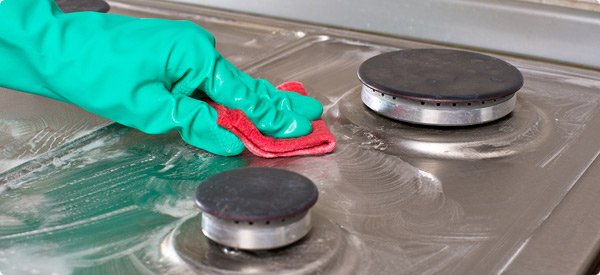Tips on How to Clean Your Stove Top
8th Mar 2016
How to Clean Your Stove Top

Conventional stovetops have always been notorious for being a pain to clean. This is unfortunate since they tend to build up grease and other stains very quickly with regular use. Luckily, we’re here to present you with SIX ways to clean your stovetop as thoroughly and efficiently as possible!
1: Soap and Water
For this method, remove the electric burners from your stovetop. Using a damp wash cloth and a little bit of mild dish soap, rinse any residue from the coils. For any cooked-on food debris that does not come off, mix a thick paste of equal parts baking soda and water, and then apply it to the troublesome spot. After about 20 minutes, scrub and rinse the burner. Replace the burner after it is thoroughly dry.
2: Salt and Baking Soda
Baking soda is known to be a very effective cleaning agent, as is table salt. Blend one tablespoon of baking soda and a tablespoon of salt. Next, add one tablespoon of water and mix the paste together. Dip a rag into the mixture and scour gunk away. Pour mixture on overflows. It absorbs liquid and makes clean up a breeze.
3: Baking Soda and Lemon
Lemons have natural grease cutting characteristics, and baking soda has natural antibacterial properties. Baking soda contains extremely fine particles that help remove baked-on stains but is gentle enough not to scratch the glass. Just sprinkle a bit of baking soda (about a handful) on a glass stovetop. Then rub the surface using a slice of lemon. Wipe the area with a damp cloth to remove any remnants of the baking soda particles and lemon pulp.
4: White Vinegar
White vinegar is the ultimate cleanser. It is used to clean glass stovetops by loosening streaks and stains. Just mix one part white vinegar with two parts tap water in an unused spray bottle, then spray the solution on your glass cooktop and wipe. The acidity of vinegar helps remove the grime. You can use this mixture for every day cleaning and disinfecting around your kitchen.
5: Olive Oil or Vegetable Oil
Oils are infamous for the messes that they can cause, but they’re also great for undoing damage by lubricating caked-on messes. This method calls for you to pour a little vegetable or olive oil out onto your stovetop. Using a cloth, scrub the oil into the grime until it begins to loosen. Then spray it down with an all-purpose cleaner. This works wonders on the hood of your stove as well.
6: Commercial Oven Cleaner
Oven cleaner tends to work well for cleaning gas stovetops. Place the removable parts on a newspaper outside or in a well-ventilated area and spray with a commercial oven cleaner. Leave them coated for a few hours or overnight. Next, scrub the burners in hot, soapy water. Use the rough side of a sponge on non-coated grates. For coated ones, use a soft cloth. Let the pieces dry completely before you replace them.
